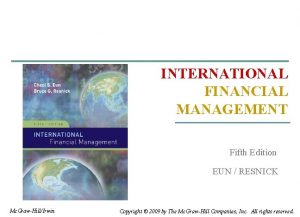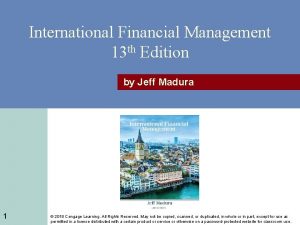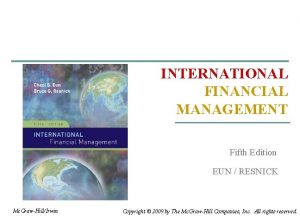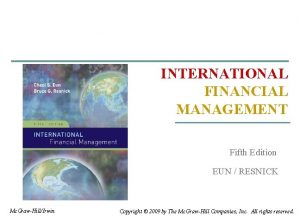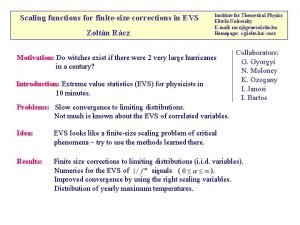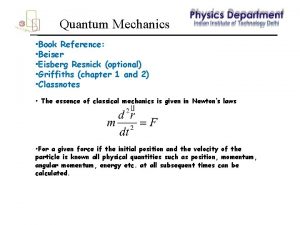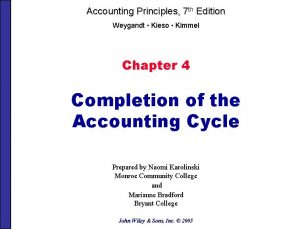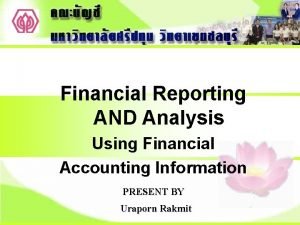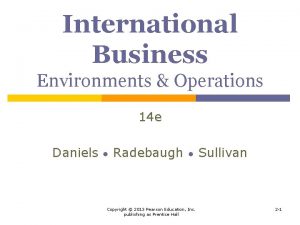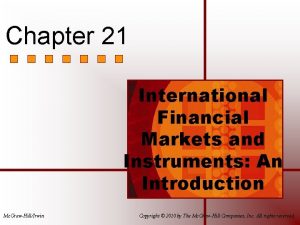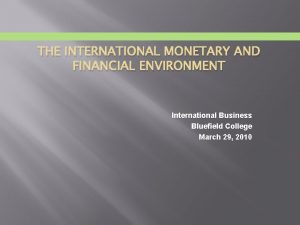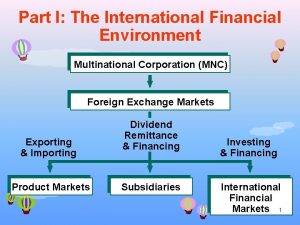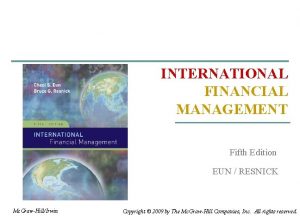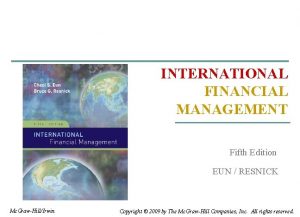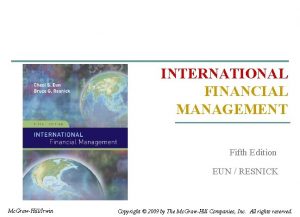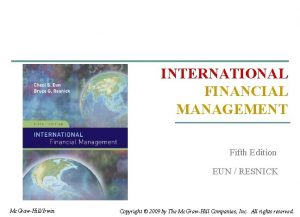INTERNATIONAL FINANCIAL MANAGEMENT Fifth Edition EUN RESNICK Mc



































- Slides: 35

INTERNATIONAL FINANCIAL MANAGEMENT Fifth Edition EUN / RESNICK Mc. Graw-Hill/Irwin Copyright © 2009 by The Mc. Graw-Hill Companies, Inc. All rights reserved.

Balance of Payments 3 Chapter Three Chapter Objective: This chapter serves to introduce the student to the balance of payments. How it is constructed and how balance of payments data may be interpreted. 3 -1

Chapter Outline l l Balance of Payments Accounting Balance of Payments Accounts l l l 3 -2 The Current Account The Capital Account Statistical Discrepancy Official Reserves Account The Balance of Payments Identity Balance of Payments Trends in Major Countries

Balance of Payments Accounting l The Balance of Payments is the statistical record of a country’s international transactions over a certain period of time presented in the form of double-entry bookkeeping. N. B. when we say “a country’s balance of payments” we are referring to the transactions of its citizens and government. 3 -3

Balance of Payments Example l l l 3 -4 Suppose that Maplewood Bicycle in Maplewood, Missouri, USA imports $100, 000 worth of bicycle frames from Mercian Bicycles in Darby England. There will exist a $100, 000 credit recorded by Mercian that offsets a $100, 000 debit at Maplewood’s bank account. This will lead to a rise in the supply of dollars and the demand for British pounds.

Balance of Payments Accounts l l The balance of payments accounts are those that record all transactions between the residents of a country and residents of all foreign nations. They are composed of the following: l l 3 -5 The Current Account The Capital Account The Official Reserves Account Statistical Discrepancy

The Current Account l l 3 -6 Includes all imports and exports of goods and services. Includes unilateral transfers of foreign aid. If the debits exceed the credits, then a country is running a trade deficit. If the credits exceed the debits, then a country is running a trade surplus.

The Capital Account l l l 3 -7 The capital account measures the difference between U. S. sales of assets to foreigners and U. S. purchases of foreign assets. In 2006, the U. S. enjoyed a $826 billion capital account surplus—absent of U. S. borrowing from foreigners, this “finances” our trade deficit. The capital account is composed of Foreign Direct Investment (FDI), portfolio investments and other investments.

Statistical Discrepancy l l 3 -8 There’s going to be some omissions and misrecorded transactions—so we use a “plug” figure to get things to balance. Exhibit 3. 1 shows a discrepancy of $18 billion in 2006.

The Official Reserves Account l 3 -9 Official reserves assets include gold, foreign currencies, SDRs, reserve positions in the IMF.

The Balance of Payments Identity BCA + BKA + BRA = 0 where BCA = balance on current account BKA = balance on capital account BRA = balance on the reserves account Under a pure flexible exchange rate regime, BCA + BKA = 0 3 -10

U. S. Balance of Payments Data 2006 Current Account Debits 1 Exports $2, 096. 3 2 Imports ($2, 818. 0) 3 $24. 4 4 5 6 7 $180. 6 $1, 017. 4 $690. 4 $826. 9 ($18) ($114. 0) ($811. 3) ($235. 4) ($426. 1) ($400) Unilateral Transfers Balance on Current Account Capital Account Direct Investment Portfolio Investment Other Investments Balance on Capital Account Statistical Discrepancies Overall Balance Official Reserve Account 3 -11 Credits ($2. 4) $2. 4

U. S. Balance of Payments Data 2006 Current Account Debits 1 Exports $2, 096. 3 2 Imports ($2, 818. 0) 3 $24. 4 4 5 6 7 $180. 6 $1, 017. 4 $690. 4 $826. 9 ($18) ($114. 0) ($811. 3) ($235. 4) ($426. 1) ($400) Unilateral Transfers Balance on Current Account Capital Account Direct Investment Portfolio Investment Other Investments Balance on Capital Account Statistical Discrepancies Overall Balance Official Reserve Account 3 -12 Credits ($2. 4) $2. 4 In 2004, the U. S. imported more than it exported, thus running a current account deficit of $811. 3 billion.

U. S. Balance of Payments Data 2006 Current Account Debits 1 Exports $2, 096. 3 2 Imports ($2, 818. 0) 3 $24. 4 4 5 6 7 $180. 6 $1, 017. 4 $690. 4 $826. 9 ($114. 0) ($811. 3) ($235. 4) ($426. 1) ($400) ($18) ($2. 4) $2. 4 Unilateral Transfers Balance on Current Account Capital Account Direct Investment Portfolio Investment Other Investments Balance on Capital Account Statistical Discrepancies Overall Balance Official Reserve Account 3 -13 Credits During the same year, the U. S. attracted net investment of $826. 9 billion— clearly the rest of the world found the U. S. to be a good place to invest.

U. S. Balance of Payments Data 2006 Current Account Debits 1 Exports $2, 096. 3 2 Imports ($2, 818. 0) 3 $24. 4 4 5 6 7 $180. 6 $1, 017. 4 $690. 4 $826. 9 ($114. 0) ($811. 3) ($235. 4) ($426. 1) ($400) ($18) ($2. 4) $2. 4 Unilateral Transfers Balance on Current Account Capital Account Direct Investment Portfolio Investment Other Investments Balance on Capital Account Statistical Discrepancies Overall Balance Official Reserve Account 3 -14 Credits Under a pure flexible exchange rate regime, these numbers would balance each other out.

U. S. Balance of Payments Data 2006 Current Account Debits 1 Exports $2, 096. 3 2 Imports ($2, 818. 0) 3 $24. 4 4 5 6 7 $180. 6 $1, 017. 4 $690. 4 $826. 9 ($114. 0) ($811. 3) ($235. 4) ($426. 1) ($400) ($18) ($2. 4) $2. 4 Unilateral Transfers Balance on Current Account Capital Account Direct Investment Portfolio Investment Other Investments Balance on Capital Account Statistical Discrepancies Overall Balance Official Reserve Account 3 -15 Credits In the real world, there is a statistical discrepancy.

U. S. Balance of Payments Data 2006 Current Account Credits Debits 1 Exports $2, 096. 3 2 Imports ($2, 818. 0) 3 $24. 4 4 5 6 7 $180. 6 $1, 017. 4 $690. 4 $826. 9 ($114. 0) ($811. 3) ($235. 4) ($426. 1) ($400) ($18) ($2. 4) $2. 4 Unilateral Transfers Balance on Current Account Capital Account Direct Investment Portfolio Investment Other Investments Balance on Capital Account Statistical Discrepancies Overall Balance Official Reserve Account Including that, the balance of payments identity should hold: BCA + BKA = – BRA ($811. 3) + $826. 9 + ($18) = ($2. 4) 3 -16

Balance of Payments and the Exchange Rate Current Account Exchange rate $ Debits 1 Exports $2, 096. 3 2 Imports ($2, 818. 0) 3 $24. 4 4 5 6 7 $180. 6 $1, 017. 4 $690. 4 $826. 9 ($114. 0) ($811. 3) ($235. 4) ($426. 1) ($400) ($18) ($2. 4) $2. 4 Unilateral Transfers Balance on Current Account Capital Account Direct Investment Portfolio Investment Other Investments Balance on Capital Account Statistical Discrepancies Overall Balance Official Reserve Account 3 -17 Credits P S D Q

Balance of Payments and the Exchange Rate Current Account Credits Exchange rate $ Debits 1 Exports $2, 096. 3 2 Imports ($2, 818. 0) 3 $24. 4 4 5 6 7 $180. 6 $1, 017. 4 $690. 4 $826. 9 ($114. 0) ($811. 3) ($235. 4) ($426. 1) ($400) ($18) ($2. 4) $2. 4 Unilateral Transfers Balance on Current Account Capital Account Direct Investment Portfolio Investment Other Investments Balance on Capital Account Statistical Discrepancies Overall Balance Official Reserve Account P S D Q As U. S. citizens import, they are supply dollars to the FOREX market. 3 -18

Balance of Payments and the Exchange Rate Current Account Credits Exchange rate $ Debits 1 Exports $2, 096. 3 2 Imports ($2, 818. 0) 3 $24. 4 4 5 6 7 $180. 6 $1, 017. 4 $690. 4 $826. 9 ($114. 0) ($811. 3) ($235. 4) ($426. 1) ($400) ($18) ($2. 4) $2. 4 Unilateral Transfers Balance on Current Account Capital Account Direct Investment Portfolio Investment Other Investments Balance on Capital Account Statistical Discrepancies Overall Balance Official Reserve Account P S D Q As U. S. citizens export, others demand dollars at the FOREX market. 3 -19

Balance of Payments and the Exchange Rate Current Account Credits Exchange rate $ Debits 1 Exports $2, 096. 3 2 Imports ($2, 818. 0) 3 $24. 4 4 5 6 7 $180. 6 $1, 017. 4 $690. 4 $826. 9 ($114. 0) ($811. 3) ($235. 4) ($426. 1) ($400) ($18) ($2. 4) $2. 4 Unilateral Transfers Balance on Current Account Capital Account Direct Investment Portfolio Investment Other Investments Balance on Capital Account Statistical Discrepancies Overall Balance Official Reserve Account P S S 1 D Q As the U. S. government sells dollars, the supply of dollars increases. 3 -20

Sovereign Wealth Funds l l 3 -21 Government-controlled investment funds are playing an increasingly visible role in international investments. SWFs are mostly domiciled in Asian and Mid. East countries usually are responsible for recycling foreign exchange reserves of these countries swelled by trade surpluses and oil revenues.

Change in the Trade Balance The J-Curve Effect 3 -22 Following a currency depreciation, the trade balance may at first deteriorate before it improves. Time The shape depends on the elasticity of the imports and exports. As an example, consider an imported good for which there is no domestic producer. If demand is price inelastic, then following a depreciation the trade balance gets worse (until domestic production begins).

Balance of Payments Trends l l 3 -23 Since 1982 the U. S. has experienced continuous deficits on the current account and continuous surpluses on the capital account. During the same period, Japan has experienced the opposite.

Source: IMF International Financial Statistics Yearbook, various issues 3 -24

Source: IMF International Financial Statistics Yearbook, various issues 3 -25

Balance of Payments Trends l Germany traditionally had current account surpluses. l l 3 -26 From 1991 to 2001 Germany experienced current account deficits. This was largely due to German reunification and the resultant need to absorb more output domestically to rebuild the former East Germany. Since 2001 Germany returned to its earlier pattern. What matters is the nature and causes of the disequilibrium.

Source: IMF International Financial Statistics Yearbook, various issues 3 -27

Mercantilism and the Balance of Payments l l l 3 -28 Mercantilism holds that a country should avoid trade deficits at all costs, even to imposing various restrictions on imports. Mercantilist ideas were criticized in the 18 th century by such British thinkers as Adam Smith, David Ricardo, and David Hume. They argued that the main source of wealth in a country is its productive capacity not its trade surpluses.

End Chapter Three Start Chapter 3 appendix. 3 -29

Relationship between Balance of Payments and National Income Accounting l 3 -30 National income (Y), or gross domestic product (GDP) is equal to the sum of the nominal consumption (C) of goods and services, private investment (I), government spending (G), and the difference between exports (X) and imports (M): Y ≡ GDP ≡ C + I + G + (X – M)

Relationship between Balance of Payments and National Income Accounting l l 3 -31 Private savings is defined as the amount left from national income after consumption and taxes (T) are paid: S ≡ Y – C – T or S ≡ C + I + G + (X – M) – C – T Note that BCA ≡ X – M and we can rearrange the last equation as (S – I) + (T – G) ≡ X – M ≡ BCA

Relationship between Balance of Payments and National Income Accounting l l l 3 -32 (S – I) + (T – G) ≡ X – M ≡ BCA This shows that there is an intimate relationship between a country’s BCA and how it finances its domestic investment and pays for government spending. If (S – I) < 0 then a country’s domestic savings is insufficient to finance domestic in vestment. Similarly, if (T – G) < 0, then tax revenue is insufficient to cover government spending and a government budget deficit exists.

Relationship between Balance of Payments and National Income Accounting l l (S – I) + (T – G) ≡ X – M ≡ BCA When BCA < 0, government budget deficits and or part of domestic investment are being financed by foreign-controlled capital. To reduce a BCA deficit, one of the following must occur: l l l 3 -33 For a given level of S and I, the government budget deficit (T – G) must be reduced For a given level of I and (T – G), S must be increased For a given level S and (T – G), I must fall.

End Chapter Three 3 -34
 Eun and resnick
Eun and resnick International financial management jeff madura 13th edition
International financial management jeff madura 13th edition Expanded opportunity set international finance
Expanded opportunity set international finance International financial management definition
International financial management definition International financial management 13th edition
International financial management 13th edition International financial management 5th edition
International financial management 5th edition Resnick
Resnick Resnick
Resnick Mitch resnick scratch
Mitch resnick scratch Ankle brachial index
Ankle brachial index Dr. resnick
Dr. resnick Principles of marketing fifth european edition
Principles of marketing fifth european edition Lazarus cognitive appraisal theory
Lazarus cognitive appraisal theory Fundamentals of corporate finance fifth edition
Fundamentals of corporate finance fifth edition Democritus atomic model diagram
Democritus atomic model diagram Segregat
Segregat Molecular biology
Molecular biology Human anatomy fifth edition
Human anatomy fifth edition Human anatomy fifth edition
Human anatomy fifth edition Fcl.eun.org
Fcl.eun.org Eun deun dip
Eun deun dip Partes del discruso
Partes del discruso International human resource management dowling 6th edition
International human resource management dowling 6th edition Using mis (10th edition) 10th edition
Using mis (10th edition) 10th edition Using mis (10th edition)
Using mis (10th edition) Kimmel accounting 5th edition
Kimmel accounting 5th edition Kimmel financial accounting 7the edition
Kimmel financial accounting 7the edition Financial accounting ifrs 4th edition chapter 12
Financial accounting ifrs 4th edition chapter 12 Using financial accounting information 10th edition
Using financial accounting information 10th edition Religion as a cultural stabilizer
Religion as a cultural stabilizer Financial motivators
Financial motivators International financial markets and instruments
International financial markets and instruments International monetary and financial environment
International monetary and financial environment International monetary and financial environment
International monetary and financial environment The international financial environment
The international financial environment Levich international financial markets
Levich international financial markets
